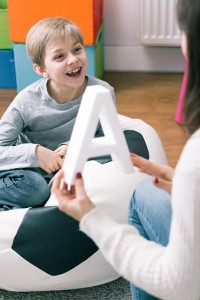Is your infant not babbling? Have inconsistent sound errors? Or is he/she a late talker? While these signs can indicate Childhood Apraxia of Speech (CAS), they can also be symptoms of other speech-language disorders.
The American Speech-Language-Hearing Association (ASHA) identifies the difference between a speech, language disorders and Apraxia of speech.
 Speech Disorder
Speech Disorder
Speech is how we say sounds and words. People with speech problems may:
not say sounds clearly, have a hoarse or raspy voice, repeat sounds or pause when speaking, called stuttering
Language Disorder
Language is the words we use to share ideas and get what we want. A person with a language disorder may have problems:
understanding, talking, reading, and writing
Childhood Apraxia of Speech
During Apraxia of speech, occurs when the message that comes from the brain and goes to the mouth doesn’t get through like it should. This message is responsible for how the muscles move to make sounds. Even though, the child’s tongue and lip muscles are strong, they may not be moving the right way.
Currently, there are no validated diagnostic features that differentiate CAS from other childhood speech sound disorders. However, three segmental and suprasegmental features consistent with a deficit in the planning and programming of movements for speech have gained some consensus among those investigating CAS:
-
- Inconsistent errors on consonants and vowels in repeated productions of syllables or words.
- Lengthened and disrupted coarticulatory transitions between sounds and syllables.
- Inappropriate prosody, especially in the realization of lexical or phrasal stress.
Importantly, these features are not proposed to be the necessary and sufficient signs of CAS. The frequency of these and other signs may change depending on task complexity, age of the child, and severity of symptoms.
Other Reported Characteristics
 Other characteristics that have been reported in children diagnosed with CAS and that represent difficulty with the planning and programming movement gestures for speech include
Other characteristics that have been reported in children diagnosed with CAS and that represent difficulty with the planning and programming movement gestures for speech include
-
- articulatory groping—articulatory searching prior to phonating;
- consonant distortions;
- difficulty with smooth, accurate movement transitions from one sound to the next;
- increasing difficulty with longer or more complex syllable and word shapes;
- schwa additions/insertions—insertion of schwa between consonants or at the end of words;
- slower than typical rate of speech
- syllable segregation—pauses between sounds, syllables, or words that affect smooth transitions;
- voicing errors—voiceless sounds produced as their voiced cognates; and
- vowel errors—vowel distortions or substitutions.
Support From Family and Speech Therapist
Any type of speech/language disorder need support from parents, caregivers and a speech language pathologist (SPL). Working together helps ensures success.


